2nd generation Infortrend EonStor DS2024 storage system review and testing
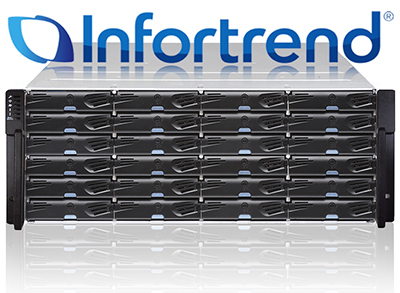 In the article “DSS Infortrend is an alternative to A-brands. Review and testing ” we described the functionality and performance of one of the most popular at that time SAN Infortrend - DS 3012T. According to the results of the previous article, we took the support of classic Enterprise drives (non-branded) and ensuring the operation of SATA drives in 2-controller systems to the advantages of storage systems Infortrend. These facts make these storage systems unique because Using SATA SSD Enterprise, you can build a budget storage system with high performance and fault tolerance.
In the article “DSS Infortrend is an alternative to A-brands. Review and testing ” we described the functionality and performance of one of the most popular at that time SAN Infortrend - DS 3012T. According to the results of the previous article, we took the support of classic Enterprise drives (non-branded) and ensuring the operation of SATA drives in 2-controller systems to the advantages of storage systems Infortrend. These facts make these storage systems unique because Using SATA SSD Enterprise, you can build a budget storage system with high performance and fault tolerance.In this article, we will look at the 24-disk SAN model of the 2000th series, and pay more attention to the Infortrend SANWatch management interface.
Multi-generation Infortrend line performance comparison
Last year, Infortrend released the second generation of SAN-systems EonStor DS, in which the processors were updated, the maximum amount of RAM was increased, and the main difference was the transition to a 12-gigabit disk interface, which significantly affected the performance of especially younger models.

')
The comparison table shows that the younger series of the last generation (DS 2000 Gen2 is the topic of this article) was almost equal in performance with the older series of the previous generation (DS 3000T is the topic of the previous article). The 2000th series has a slight lag in IOPs and equal MB / sec, but at the same time, the second generation has twice the fast SAS interface and a larger number of removable disks.
Stand Specification
Infortrend ESDS 2024 Gen2 storage system consisting of:
Form factor: 4U Rackmount (depth - 500 mm)
Set for installation in 19 "a rack. Distance between frames from 23" to 37 "
Dual RAID controller (High IOPS)
RAID level 0, 1 (0 + 1), 3, 5, 6, 10, 30, 50, 60
4GB DDR-III Dual Controller (optional up to 32GB DDR-III Dual Controller)
2 x FBWC Module
Host ports are standard: (4 + 4) x 1GbE - RJ-45 (iSCSI)
Host ports optional: (4 + 4) x 1GbE - RJ-45 (2 + 2) x 10GbE - SFP + (iSCSI)
(2 + 2) x 10GbE - RJ-45 iSCSI
(4 + 4) x 16Gb FC
(4 + 4) x 8Gb FC / (2 + 2) x 16Gb FC / (4 + 4) x 10Gb iSCSI (converged)
(2 + 2) x 12Gb SAS
(2 + 2) x 40GbE - QSFP
Expansion ports: (1 + 1) x SAS 12G x4
Up to 444 HDD in one system (with additional JBOD Infortrend connected)
24 HotSwap SerialATA / SAS Disk Bays
10 x SAS SSD 3,8TB Toshiba PX05SVB384: MLC, Dual port 12 Gbit / s, 270k IOPS random read (4K), 3 DWPD
10 x SAS SSD 1,9TB Toshiba PX05SVB192: MLC, Dual port 12 Gbit / s, 270k IOPS random read (4K), 3 DWPD
40 x SAS HDD 1,2TB HGST Ultrastar HUC101812CS4200: 10520 RPM, 128MB Cache, 12Gb / s (via JBOD Infortrend)
Failsafe power supply with hot-swappable 1 + 1 460W
Cachesafe
SSD Cache (optional)
Multi-pathing
Thin provisioning
Automated Storage Tiering (optional 2 tiers / 4 tiers)
Local replication
Advanced Local Replication: Snapshot and Volume Copy / Mirror (optional)
Remote Replication (optional)
Device mapper
Management: SANWatch management suite, Terminal via RS-232C, Telnet / SSH, LCD keypad panel
Notifications: Email, Fax, LAN broadcast, SNMP traps, SMS, Skype
Infortrend warranty 36 months. Repair and maintenance in the service center STSS.
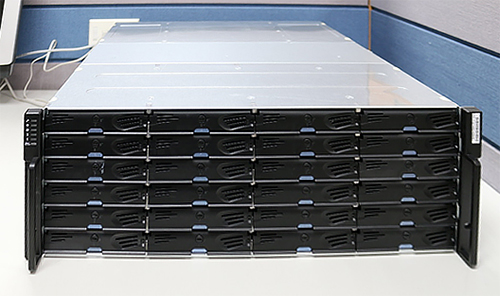
The capacious 4U-case allows you to install up to 24 2.5 "/ 3.5" disks, while having a depth of just 500 mm. In the basic configuration, DS 2024 G2 is equipped with 4 x Gigabit RJ-45 (iSCSI) Host Interfaces for each controller. The controllers of this storage model are independent of each other, but work in pairs, providing fault tolerance. Each controller supports the installation of one interface expansion card.
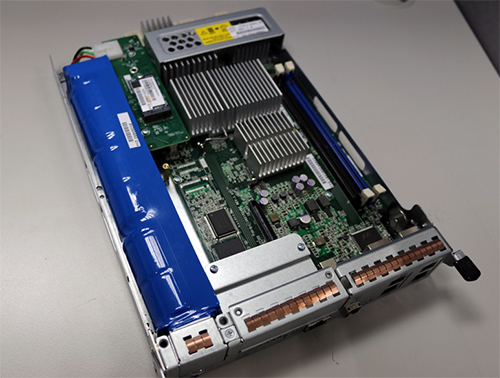
460 W power supplies also reserve each other, evenly distributing the load among themselves.
Management Interface Infortrend SANWatch
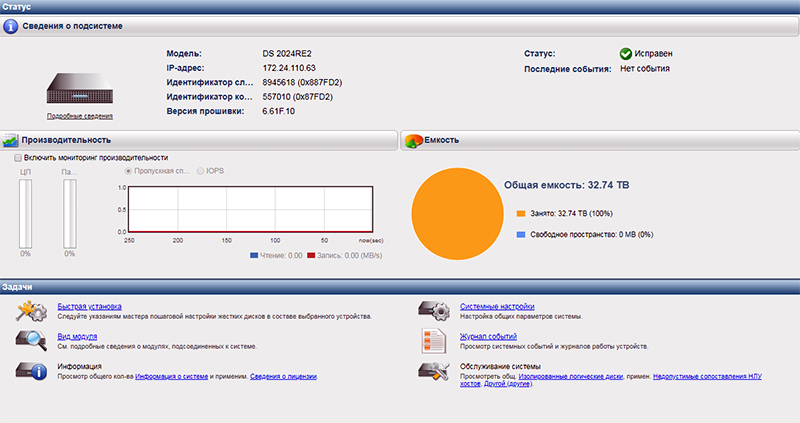
SANWatch software includes tools for configuring data storage, monitoring arrays, disks, and the system as a whole. SANWatch provides administrator notification when various system problems occur. Storage Infortrend allows you to organize RAID-arrays of the following levels: (RAID 0, 1, (0 + 1), 3, 5, 6, 10, 30, 50, 60).
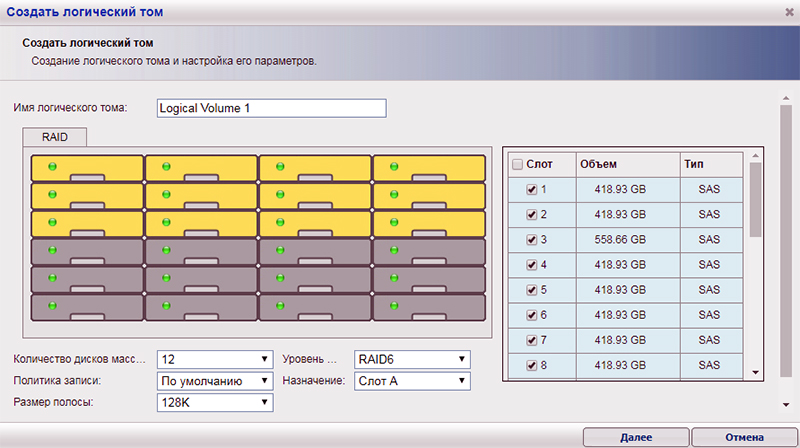
When creating a logical volume, the necessary disks are marked, the RAID level is selected, and, if necessary, the SED (Self Encrypting Drives) function is activated.
Thin / Full Provisioning (Thin / Full Placement)
When creating a partition, you can select the initialization option after creation, i.e. allocation of disk space in full at the time of creation (Full provisioning).
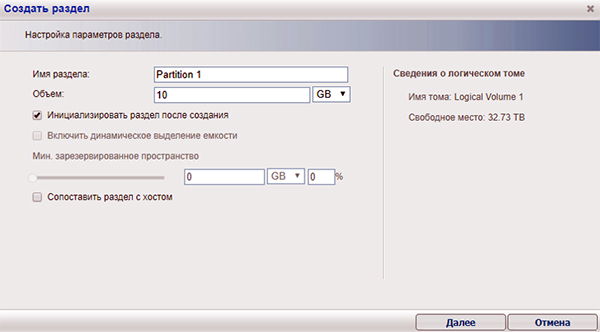
If a partition must be dynamic, then dynamic allocation of capacity (Thin provisioning) is turned on, with an indication of the minimum amount reserved for this partition.
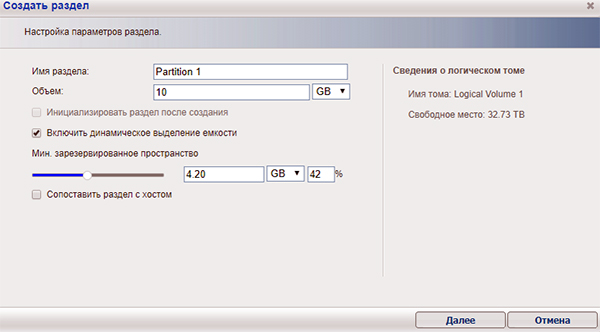
Local / Remote Replication (Local / Remote Replication)
You can back up a volume (synchronous or asynchronous) in two ways. Either within the same subsystem (Local replication) or to the remote storage system Infortrend (Remote replication).
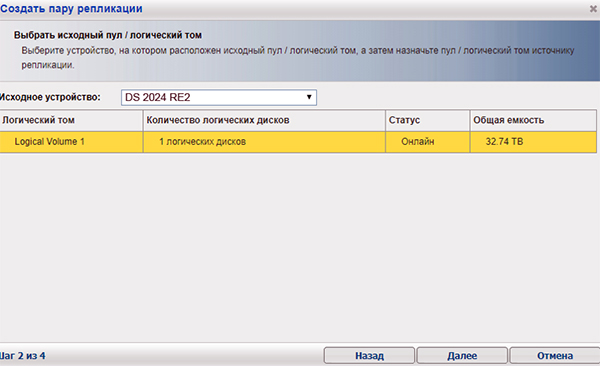
Snapshots

A Snapshot feature is also available, which can be configured on a schedule.
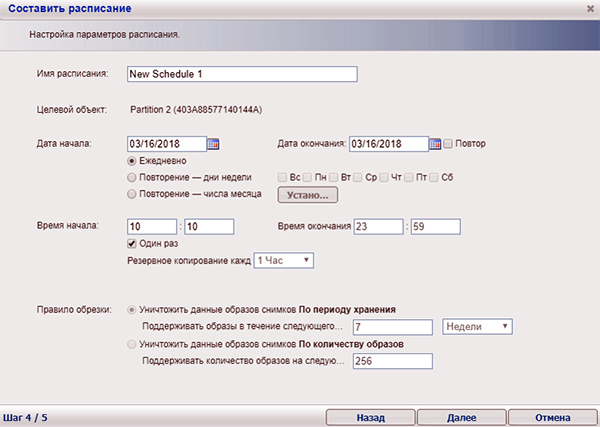
Auto-tiering
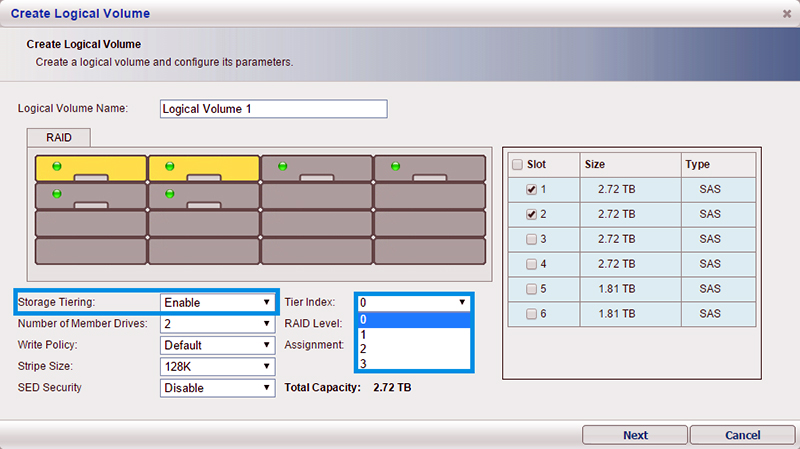
The function of automatic distribution of data across the levels includes the use of various types of drives: SSD, SAS, NL-SAS and SATA. It allows you to increase performance and volume at the same time, due to the intellectual migration of "cold" and "hot" data between arrays based on the optimal type of drives.

But, in my opinion, 4-level tearing in current realities loses its relevance. SATA and NL SAS drives are almost equal, given the need to use MUX for SATA in 2-controller systems. Thus one level disappears. Well, SAS HDD 10 / 15K is already a dying look. The cost for TB is getting closer to the SSD, and the performance is not far from the 7.2K HDD. Therefore, I don’t see any sense in having a dubious layer in the form of hot SAS disks of a small volume. There remains an ideal 2-level tearing, which is also well supported by Infortrend systems: “hot” data on SSD, and “cold” data - on NL SAS.
SSD Cache
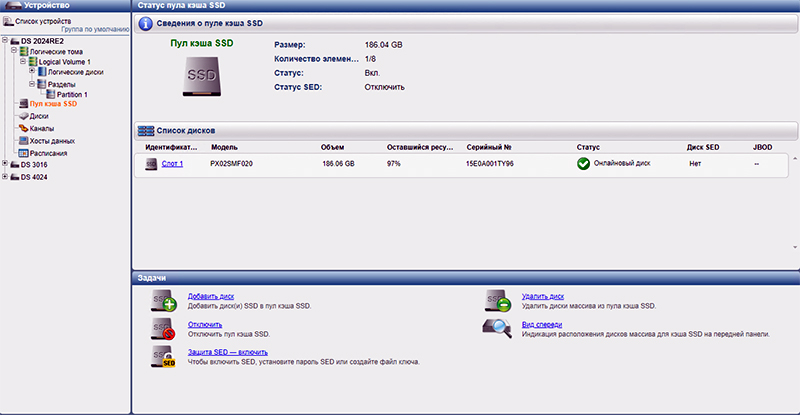
The SSD cache function speeds up the re-reading of “hot” data (for example, Microsoft SQL, Mail Server, CRM, SAP and VDI), automatically moves a copy of the most frequently used data from hard drives to the SSD-based cache pool.

Testing
To confirm the performance level of the Infortrend storage system, a server with Xeon E5-2620V4 running Windows Server 2012 R2, equipped with Emulex LightPulse FC 16 Gb / s 2-port adapters was used. For testing, 4 configurations of the disk array and 4 load modes were chosen.
Configurations:
1. RAID5 : 10 x TOSHIBA SAS SSD 3.84TB + 10 x TOSHIBA SAS SSD 1.92TB
2. RAID6 : 10 x TOSHIBA SAS SSD 3.84TB + 10 x TOSHIBA SAS SSD 1.92TB
3. RAID5 : 40 x HGST SAS HDD 1.2TB with JBOD
4. RAID6 : 40 x HGST SAS HDD 1.2TB with JBOD
Load Scenarios:
1. Sequential read / write
2. Random read / write
3. Database
4. VDI

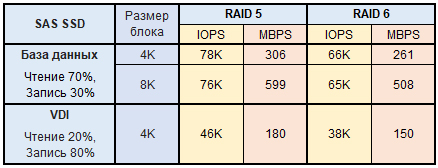


Test results provided by R & D Infortrend, confirmed the stated characteristics of this model of storage.
In conclusion, I repeat: the main advantage of SAN Infortrend is classic drives at market value, and support for SATA drives in 2-controller systems. This scheme reduces performance and, in the case of the HDD, is meaningless. But for SATA SSD - this is widely applicable. The storage is maximally budget and sufficiently productive, and the cost of one IOPs of such a solution is the most profitable in comparison with similar 2-controller systems.
You can estimate the cost of the solution in the required configuration on our website in the Infortrend Storage Systems section .
According to the code word “HABR”, 5% discount for 1-controller models of ESDS, and 7% for 2-controller models.
Thanks for attention!
Source: https://habr.com/ru/post/354554/
All Articles